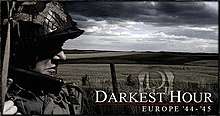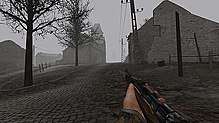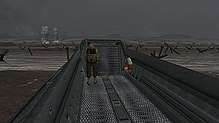Darkest Hour: Europe '44-'45
Darkest Hour: Europe '44-'45 is a free modification developed by Darklight Games / The Darkest Hour Team for Tripwire Interactive's multiplayer first-person shooter video game Red Orchestra: Ostfront 41-45, It is based on the Western Front during World War II between 1944 and 1945, depicting the conflict between Allied and German forces. Several large-scale operations are covered, including the invasion of Normandy, Battle of the Bulge, Operation Market Garden, and Battle of the Hürtgen Forest.[1]
| Darkest Hour: Europe '44-'45 | |
|---|---|
 | |
| Engine | Unreal Engine 2.5 |
| Platform(s) | Microsoft Windows, Linux |
| Release | June 6, 2008 |
| Genre(s) | Tactical first-person shooter |
| Mode(s) | Multiplayer |
Gameplay


Darkest Hour's gameplay style is similar to its parent game, Red Orchestra: Ostfront 41-45, although with many expansive changes especially to the armor system, have many features such as the round shatter, overmatch, the ability to break the traverse of the turret, optics, kill tank crew with a penetrating shot, different ammo types such as APDS, HVAP, and HEAT, tank brew ups and many other features not found in the original game.
Players assume the role of an individual infantryman or tank crew from either the Allied or German forces in an online multiplayer environment. Each team then attempts to accomplish objectives varying by the historical battle the game map is based upon. The main type of play consists of an Attack and Defend style, whereby one team has to take objective areas from the opposing team in order to claim victory.
The game features a complete change of content from its parent in the form of entirely new battlegrounds, vehicles, weapons and uniforms. The Allied team players get the chance to play the role of an American, British or Canadian soldier, while the Axis team play as a soldier from the Waffen SS, Fallschirmjäger and other German divisions.
Over 20 World War II era firearms can be used including the M1 Garand, M1 Carbine, .30-cal, Bren LMG, FG 42, Thompson, Lee–Enfield, American Bazooka, British PIAT and German Panzerschreck. Crewable vehicles include the King Tiger, Jagdpanther, Sherman, Cromwell, M10 Wolverine and Kübelwagen.
Other new improvements have been made to increase gameplay realism, such as bullet suppression, wall mantling, supersonic cracks, shell shock, deployable mortars, player/vehicle damage, and a playable radioman class required for calling in artillery strikes.[2]
Battle locations (official maps)
The following maps were available as of the latest official release:
- Juno Beach – Canadians storming the beach in D-Day-style action.
- Carentan – The US 101st Airborne assaults the town shortly after D-Day.
- Brecourt – 101st Airborne attempt to put a key German artillery battery out of commission behind the beaches.
- Vieux – Vast, sweeping armored combat as the British attempt to break out during Operation Goodwood in Normandy.
- Ginkel Heath (near Ede, Netherlands) – British paratroopers drop into a hotly contested landing zone at the start of Operation Market-Garden.
- Wacht-am-Rhein – German armor attempts to seize critical roadways from an American armored unit in the opening hours of the Ardennes Offensive.
- Stoumont – American infantry and armor try to hold back SS PanzerGrenadiers in the streets of a demolished Ardennes town.
- Bois Jacques – Americans in trench-style defense against a combined German tank and infantry force in the forests between Bastogne and Foy, Belgium.
- Foy – German forces defend against attacking American Airborne troopers deep in the Ardennes.
- Noville -
- DogGreen - D-Day 0600hrs - Omaha Beach: Dog Green Sector
- Raids - A British Airborne unit, backed by Cromwell tanks, attempts to take a French town from dug in German troops.
- La Monderie - This is a fictional tank battle taking place in September 1944 somewhere in the country side of France.
- Freyneux and Lamormenil - This map closely models the actual terrain of the Freyneux-Lamormenil area of Belgium in December 1944.
- La Chapelle - In this scenario, US infantry forces supported by a section of tanks must seize the village from a Germany Infantry force.
- Hurtgenwald - While the Hurtgen Forest attracts tourists today because of its forested hills, lakes, and rivers, in 1944 and 1945 it was the site of the longest and bloodiest battles in the history of the U.S. Army.
- Vieux Recon - Commonwealth recon forces run into their German counterparts just north of Caen in the early dawn hours.
- Carentan Causeway
- Cambes-en-Plaine - British armor encounters elements of the 12.SS Panzer Division on D-Day +1.
- Caen
- Poteau Ambush - Kamfgruppe Hansen of the 1.SS Leibstandarte ambush a convoy of the American 14th Cavalry Group.
- Hill 108
- Hill 400
- Kommerscheidt
- Simonskall
- Lutremange
- Bridge Head
- Gran
Additionally, unofficial community-made maps are widely hosted on Darkest Hour's multi-player servers.
History
Development on the game started in November 2006 and was first released publicly on June 6, 2008 as Darkest Hour: Normandy 1944 (to coincide with the 64th anniversary of D-Day). The original Darkest Hour development team, known as Darklight Games, amassed dozens of contributors prior to the game's first release. For the subsequent second and third releases the entire team was downsized to "provide an efficient core team of multi-skill leads with a network of contributors who help whenever they can".
After several members of the original development group departed following the second release, the Darklight name was dropped in favor of the more general, Darkest Hour Team. In order to reach a broader audience, this consolidated group, composed of remaining original team members along with new talent, produced a substantially overhauled version of the game culminating in an acclaimed re-release through Steam in June 2009 under its current title, Darkest Hour: Europe '44-45.
In the intervening years, three more updates to the game have been released via Steam, adding additional maps, vehicles, weapons, and game features.
The developers plan to provide official support for Darkest Hour in its current incarnation through the Autumn of 2011. The current version was released on December 16, 2011.[3]
Future
After 8.0 was released end 2017 the developers are still working on adding content to the game. Some original Red Orchestra maps and stuff have been added to the mod. Currently, some work has begun on adding Mare Nostrum content, another mod for Red Orchestra 41–44, to Darkest Hour. The game is still played internationally, with several actively hosted European servers.[4]
Reception
Darkest Hour made it into ModDB's top 100 unreleased mods of 2007. Egames.de, a prominent German gaming website, featured the game upon its release.
References
- "Darkest Hour: Europe '44-'45". Jackboot Games & Tripwire Interactive.
- "Darkest Hour on Steam". Valve.
- "About Darkest Hour". Jackboot Games, LLC & Tripwire Interactive.
- http://www.darkesthourgame.com/index.php?option=com_content&view=frontpage&Itemid=53
External links
- Darkest Hour: Europe '44-'45 at Steam
- Darkest Hour: Europe '44-'45 at Facebook
- Darkest Hour: Europe '44-'45 at YouTube
- Darkest Hour ModDB page